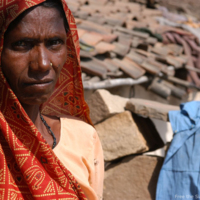
I was about 14 was when I joined for bonded labor. I took sheep for herding and at night I would supply water. I would go to sleep at 1:00 and at 3:00 my master would wake me up to do more work. He had many cattle and buffalo that I needed to clean up. My caste is SC/ST, there is only one caste in our village, but there are multiple castes in surrounding villages. When I was 16 years old I went to night school for five years in order to learn how to write and read. That is when I started working for bonded labor. I got married and now have three daughters and one son. My eldest daughter got married, my son is also in labor as an agricultural worker, my next daughter is ready to be married, and my youngest daughter is 17 years old. My son-in-law ran in an election and won, he’s now in a reserved seat. I make sure to vote at all levels in elections.
My father who has passed away was a laborer, he took land for leases and rented land. I currently have one and a half hectares of land where I grow groundnut. Three of my children assist me with the agricultural work, my wife is unable to work because her legs are not able to support her to stand. She stays in one place from time to time. We do not have any bonded laborers working for us, only some daily labors who come from time to time. I don’t have the economical strength to keep any bonded laborers. It requires at least 15,000 rupees to keep a bonded laborer. If I had that money I would utilize it for something else that I need. Farmers cannot be lazy, they have to work well physically.
I don’t think I’m well off, but to some extent I am running my life. I have about 40,000 rupees of debt at the moment. I got this debt from buying a new black court, I then sold my ox and bought something else. I owe money to a couple people in our village and then a person from another village. My interest rate is two rupees, I’ve had this debt for eight years now. I haven’t been paying any principle amount but I pay in trust.
I spend all of my time in my field to do work. I worked as a bonded laborer for a few different landlords. I worked for two different people for 5 years each and then 10 years for the third person.1 I still see them everyday around the village, I keep relations with all but one landlord. Once I turned 24 and got married my father gave me some oxen to sell so that I could pay off my debt. At that time I was working for 80 rupees a year. I work day and night without any rest because I want to be able to look after my wife and children better. I work hard because working hard will get me out of these problems.
My first debt was 1,000 rupees and then took two other loans for 5,000 rupees. I took other small amounts here and there but my family told me not to take anything else until I was able to repay the amount I owed first. After I got married I went to the next landlord’s house for bonded labor. I took a 10,000 rupee advance from him. I had to give the landlord my new conditions. I told him that I would only work during the day because I had to look after my wife at night.
There are three different types of landlords. One type is mean and hateful, one just doesn’t care lets their laborer sit outside, and the third type is loving. 2Among the four landlords I worked for there was one that beat me and threatened me a few times. This happened when I was young. I went and complained to my father, after that people told the landlord not to threaten me in the future ever again. I was treated well for the remaining time with that landlord and my future landlords. There was one master that I called by name, at night he would teach people to read and write but would never take their money because he saw talent in people and wanted them to learn. People were affectionate to him because of that. Because I was young I think my master did the right thing by beating me because it trained me to do well. This was how I was able to train my son.3 I need to beat my son in order for him to learn certain things. Nowadays he doesn’t like this type of training.
The new generation of farmers in this area must keep bonded laborers because they wanted to keep their children in school to study. I know that there are laws against bonded labor in India. Some landlords in this area still continue to do it. Some of these landlords still call me for daily labor and I go whenever I’m able to. Whenever I was sick some landlords would give me 10 or 20 rupees to go the nearby hospital, my other landlord who treated me badly would tell me that I had to work, even when I was sick.
Narrative provided by
Austin Choi-Fitzpatrick, Telling Stories: What Competing Narratives about Slavery tell us about Emancipation (forthcoming)









